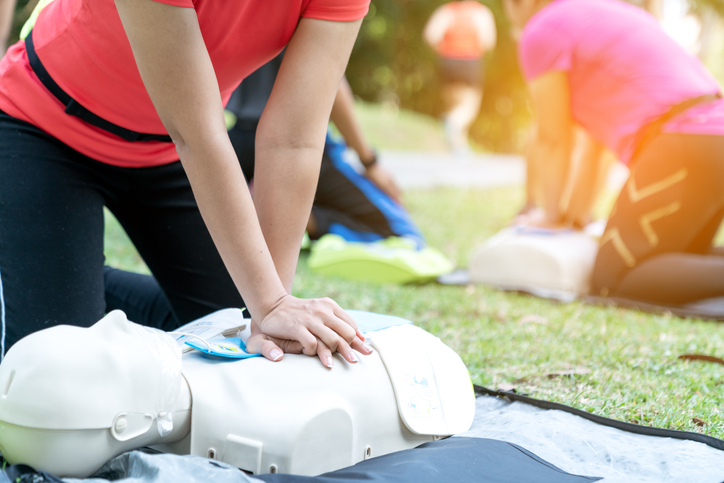
Lifesaving treatment on and off the field, VCU Health experts highlight need for immediate care for cardiac arrests
VCU Health experts share perspectives on cardiac arrest and treatment options in light of a medical emergency during a nationally televised NFL game.
January 05, 2023 Learning how to do CPR and chest compressions in first aid training can help someone suffering from a cardiac arrest. (Getty Images)
Learning how to do CPR and chest compressions in first aid training can help someone suffering from a cardiac arrest. (Getty Images)
By Sara McCloskey
Football lovers from around the country gasped after seeing 24-year-old Damar Hamlin of the Buffalo Bills collapse on the field during a game with the Cincinnati Bengals after experiencing what appeared to be cardiac arrest, which is when someone’s heart suddenly stops beating. After the lifesaving efforts of medical professionals on the sidelines, Hamlin was taken to a Level I Trauma Center much like the one at VCU Medical Center.
“For lack of a better term: [Hamlin] died on the field,” Jeremy Turlington, M.D., a cardiologist and intensive care physician at the VCU Health Pauley Heart Center, said. “The heroic measures of this training staff and everybody at the Bengals stadium to get there as quickly and do everything. They saved his life.”
As of Wednesday night, an official cause for Hamlin’s cardiac arrest has not been released. But some medical experts, including Turlington, think he may have suffered from a rare and often deadly disruption of the heart beat called commotio cordis. It happens when someone is hit in the chest at the exact moment when the heart is in between beats. The most common sports associated with commotio cordis are baseball and hockey.
“As a cardiac intensivist, we treat cardiac arrest daily. This form of cardiac arrest is exceedingly rare. In my time over the past 13 years [at VCU Medical Center], I've never seen this happen before,” Turlington said.
When it comes to responding to a cardiac arrest, Turlington highlights the importance of getting a patient’s pulse back to a normal, organized heart rhythm through cardiopulmonary resuscitation (CPR), chest compressions and defibrillator shocks.
Every minute without a pulse means another minute without oxygen spreading throughout the body, which can potentially cause damage to the brain and other vital organs.
“Routinely here at VCU Medical Center, if patients have experienced a cardiac arrest and get a pulse back, we'll also do what we call therapeutic hypothermia. We will cool the body to try to protect the brain and other organs while the body is repairing itself from the cardiac arrest,” Turlington said.
Once a patient is stabilized, it can take several days for doctors to run all of the tests to see what the long-term recovery may look like.
According to nationwide data, between 70 and 90% of people who experience an out-of-hospital cardiac arrest die before reaching the hospital. Turlington says the vast majority of patients who survive a cardiac arrest are discharged from the hospital and live relatively normal lives.
The number of deaths can be reduced by learning the signs of a cardiac arrest and first aid, which includes training on CPR and how to use an automated external defibrillator (AED).
“It's really those people doing whatever measures they can to try to get the pulse back and the flow back to the brain. That's what saves lives,” Turlington said.
In an effort to encourage training and safety on school campuses across the commonwealth, the Children’s Hospital of Richmond at VCU (CHoR) has become an affiliate of Project ADAM. The community outreach program allows CHoR team members to grant schools a special designation if they show preparedness for responding to a sudden cardiac arrest on school grounds.
“Regardless of the activity, contact or otherwise, parents should be aware of the signs of sudden cardiac arrest and have an understanding of CPR and rapid defibrillation with an AED,” John Phillips, M.D., a pediatric cardiologist and the Project ADAM medical director at CHoR. “Parents can promote a play environment for their children prepared to address sudden cardiac arrest by advocating for early defibrillation programs such as Project ADAM.”
Project ADAM, which stands for Automated Defibrillation in Adam’s Memory, is a national non-project created in the memory of Adam Lemel, a Wisconsin teen who suffered a cardiac arrest and died while playing basketball in 1999. Currently, there are 38 Project ADAM programs in 29 states. CHoR is the first and only affiliate of the program in Virginia.



